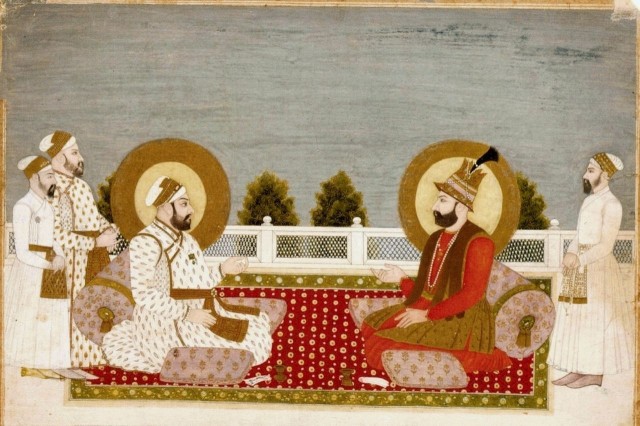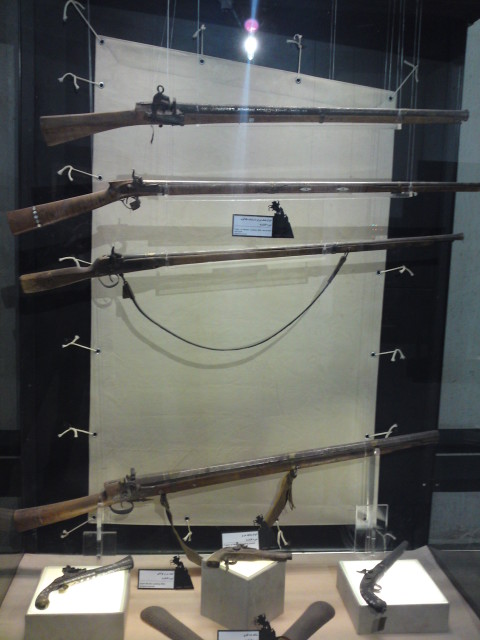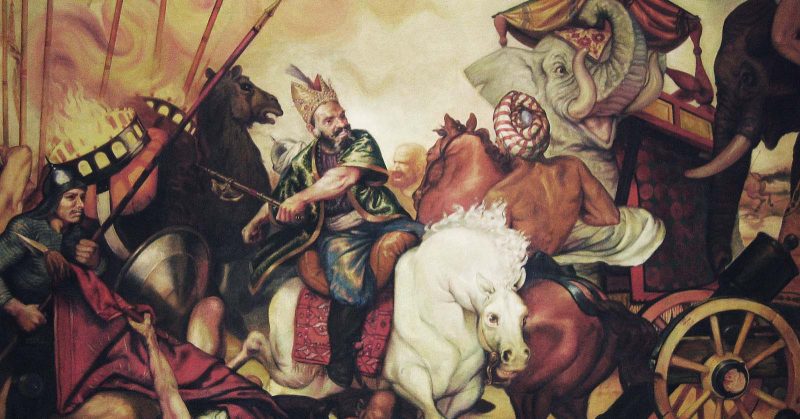Nader’s dark eyes flashed fiercely and his black beard bristled as he watched the decimated Mughal infantry crash into his centre. He was stationed with his officers and staff on the left flank of his mighty army. In command of the centre was his son, Morteza. Nader’s heart swelled with pride as the battle was joined in earnest. The date was February 24th, 1739.
From where he stood, Nader could see the great curve of the Alimardan river running in a line north to south, parallel to his deployment. To the south-west, across the river, he could just make out the towers of the walled city of Karnal. The sun flashed brightly on the bleached white stonework of its buildings. Opposite his position, he could see the camp of the Mughal Lord, Muhammad Shah.
Tents glowed white and cream in the bright sunlight, banners flew bravely in the wind, and a steady stream of soldiers, cavalry, and war elephants flowed across the river to challenge his position. The Mughal force of the Shah Muhammad was very great, but Nader was not concerned. Force of numbers would not be enough to stop him this day.
Nader was Shahanshah, King of Kings of the Afsharid dynasty of the Persian Empire, the ruler of a vast swathe of territory centred on modern-day Iran. At its height under Nader, the empire stretched from the Black Sea to the Persian Gulf, from Armenia to Bahrain, Georgia to Pakistan, Oman to the Caucasus. He was a ruthless conqueror, a tactician of the first order, and a far-sighted military reformer in a time when warfare was rapidly changing.
His origins were humble in the extreme, but luck and shrewd exploitation of opportunities had brought him, by a circuitous road, to the highest position in the land of his birth. In his youth, the Persian Empire had seen the collapse of the dynasty which had ruled for centuries. Nader made it his mission to quickly regain territory lost during this collapse, and then to pursue a policy of continuous expansion. This policy had brought him across the Indus river, marching toward the great city of Delhi in the north of India, the capital of the of the once great Mughal empire.
The Mughal empire had seen its fortunes decline over recent decades. Infighting and a failure to modernise militarily had contributed to its fragmentation. By the time Muhammad Shah faced Nadir across the Alimardan river the Mughal Empire was already a shadow of its former self. Even at the end of its strength, it was still very strong, however, and the army which Muhammad had been able to raise numbered more than a quarter of a million men.
The sheer scale of this force made it very difficult to manage, and it was, in many ways, an antiquated army. He commanded three thousand artillery pieces, but they were huge and cumbersome. The muskets of the infantry were heavy and slow to reload. Much of the Mughal force had been raised in haste from different regions and tribal groups; it could be seen more as a collection of many small forces, rather than as one unified army.
In contrast to this, Nader’s troops were most definitely unified. The army numbered around sixty thousand – far fewer than their enemy, but they were a modern force, well disciplined, well drilled, well fed and well equipped. Nader had been on campaign with this army for several years. He drilled his infantry constantly with their light, low calibre rifles.
His cavalry were some of the best in the world at the time, trained to fire rifles from horseback, to charge with lances and to fight at close quarters with Shamshirs, the great curved scimitars common to Persian soldiery. His cannons were light and mobile, and he made use of the Zamburak, a light cannon mounted on the backs of camels.
It was largely down to the Zamburak camel gunners that the Mughal infantry had taken such great losses by the time it engaged with Nadir’s centre. The camels had been used to screen the infantry, and the Mughals advanced right into the teeth of their barrage. Zamburaks were not particularly accurate guns, but their massed fire was devastating.
They fired once, twice, three times, before riding away. The infantry behind were waiting, and immediately began to deliver volley after volley into the advancing Mughals. Their losses were great, but their sheer force of numbers allowed them to reach the Persian line. They engaged fiercely, and the roars of men and the clamour of the melee filled the air.

South of the centre, Nader had laid a trap. A large body of cavalry had been sent to engage the rear of the Mughals. They had given battle, then withdrawn, and the Mughal force pursued them. As the pursuit drew level with the Persian forces, hidden musket-armed infantry began to deliver a withering wall of fire.
Zamburak camels rode swiftly up and opened fire. The Mughal war elephants screamed and trampled the infantry. Horses reared and threw their riders. The confused pursuit became a rout as the Persian cannon were brought to bear. Nader himself watched from behind the musket lines.
A great press of men, elephants and horses were engaged in the centre. More troops were pouring across the river, but the approach was choked with the dead and wounded, and the crowd was so great that there was no hope of order. Into the chaos, Nader ordered the right section of his army to engage the flank of the attacking Mughals. Cannons, muskets and Zamburaks roared from the higher ground.
The advancing Mughal troops began to break. At the front of the battle the commander of the Mughal centre, seeing the hopelessness of his position, threw up his hands in surrender. The attacking force began to disintegrate, fleeing back toward the river. The Persian infantry marched forward in orderly pursuit.

Many hundreds of Mughal officers had fallen at the front of the battle, including Muhammad Shah’s two top lieutenants. As the fleeing soldiers reached the camp, the rumour spread like wildfire of the death of their leaders. Muhammad could not order his men without his officers, and those who had escaped the massacre at the front had no will left to fight.
The Mughal army collapsed. The men looted their own camp, fleeing with whatever they could find. Amid the disaster, it became apparent that Nader had moved men under his command around to cut off their retreat and besiege the camp. The battle was over, and after some days of negotiations, Muhammad Shah surrendered and was made vassal to Nader, and to the Persian empire.
